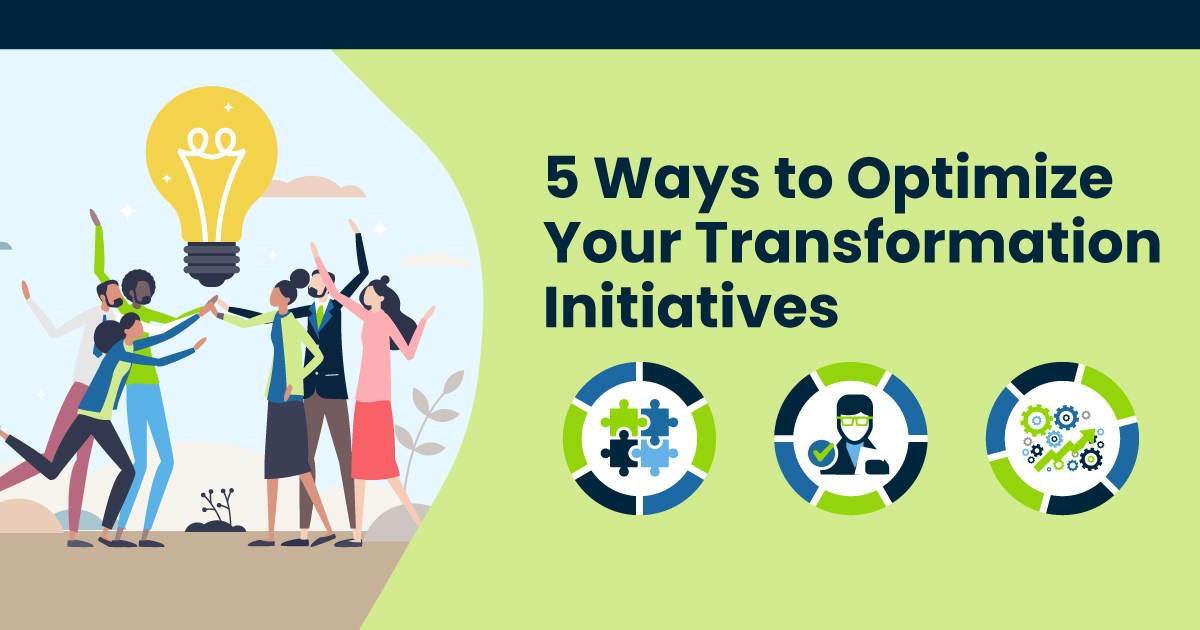
5 Ways to Optimize Your Transformation Initiatives
Your organization has exciting plans to increase efficiency and improve the customer experience. And most likely, new technology is at the forefront of your transformation initiatives. A great deal of time and effort has been put into selecting the right technologies, developing the implementation strategy, and forming project plans. But more often than not, aside from incorporating a training component for learning the new tool or platform, the people side of the change has essentially been left unaddressed.
Why does that matter?
Because people are the most critical component to the success of any transformation initiative.
It won’t matter how phenomenal a new process or solution is if it’s never accepted and adopted by the people for whom it’s built. A perfectly designed solution will never realize its potential and be truly successful without consistent and sustained user adoption. The reality is that organizational change efforts struggle to sustain results. According to McKinsey, organizational transformation initiatives fail 70% of the time.1 That’s extremely disheartening. But according to Prosci, projects that effectively apply change management are 6 times more likely to meet their project objectives.2
The Importance of Successful Individual Transitions
Effective change management strategies acknowledge that organizational change happens one person at a time. By ensuring that you support each individual through the change process, you ultimately enable and empower them to adopt new mindsets, new processes, and new technologies that transform their daily work. Only then is it possible to progress toward achieving organizational transformation. This involves actively engaging and energizing each individual around a compelling vision to realize mutual benefit.
Here are 5 ways insurers can optimize their transformation initiatives:
1. Communicate Frequently
Communication is the most important component of any transformation initiative. Transparency builds trust. It’s therefore important to communicate early and often. Have a focused and structured communication plan to avoid the generation of mixed messages and incorrect assumptions.
Start with the WHY and then address concerns before moving on to more detailed information:
- Why is the change happening?
- What are the organizational risks if the change doesn’t happen?
- How will the change impact business areas and individuals?
- How will it benefit them?
Thoughtfully determine who delivers key messages. The CEO, President, and executive leadership team members are the best people to deliver messages relating to the ‘why’. Discussions around how the change will directly impact individuals are best initiated by immediate supervisors who know the employees best.
Continually reiterate and reinforce. Best practice research states that a message needs to be communicated 5-7 times before it is understood and internalized.3 And with the amount of information we are bombarded with today, it is estimated to be much higher. But no matter the exact amount, each time we hear a message the context is expanded. And with that contextual understanding, eventually we have the capability to integrate the messaging into our actions and behaviors, producing lasting change.
2. Adequately Plan for Resistance
Resisting change is normal. Persistent resistance, however, can severely threaten the success of any transformation initiative. Developing and implementing a resistance management and coaching plan is crucial to ensuring better transitions and improving outcomes.
- Get down to the root cause of resistance and not just the symptoms.
- Remove the obstacles to successful individual transitions and try to make the change as frictionless as possible.
- Leverage early adopters. Develop a robust change agent network that can champion the transition within business areas, helping to motivate and align people around the change and its benefits.
3. Actively Engage All Stakeholders
Getting stakeholders actively engaged in any initiative dramatically increases the chances for success. Begin early. Create feedback loops and anonymous methods for employees to submit questions. Provide timely answers, even if the answer is that you don’t have the information just yet. Hold focus groups and spend time with employees to not only hear, but also address concerns. Keep the focus on facts over fears.
Understand what motivates your employees and attack engagement from all different angles. Schedule activities at set intervals that encourage participation and reinforce the transformation. If you can make it fun, that’s even better. See if there are ways to incorporate gamification into the approach to increase learning, collaboration and overall participation.
4. Measure Results & Celebrate Wins
We can’t improve what we don’t measure. Measurement helps us stay focused on facts as opposed to anecdotal information. Gathering the right data and ensuring it is actionable provides unmistakable value. Measuring results is not only critical to being able to demonstrate ROI, but it’s equally important to telling the change story. Enable quick wins and celebrate them, no matter how small. Showing progress is key to gaining interest. It also helps people maintain positivity and establishes viability for the transformation effort.
5. Incorporate Flexibility
Remain thoughtful and flexible. Gathering actionable data allows the organization to acknowledge when things might be veering a bit off course. It provides the opportunity to pivot when necessary and adjust. Adaptability is key and will keep people on board.
Going Forward
One Inc is here to help you on your digital journey. Our Client Success Team actively partners with clients to optimize their payment transformation by providing education, digital adoption best practices, digital payment data and metrics, and best-in-class benchmarking. With One Inc at your side, continually adding value, digital transformation success is achievable.
Sources:
Tags: Customer Experience

Written by The One Inc Content Team
The One Inc Content Team strives to provide valuable insights about digital trends and payments innovation for the insurance community.
Want to read more articles like this?

